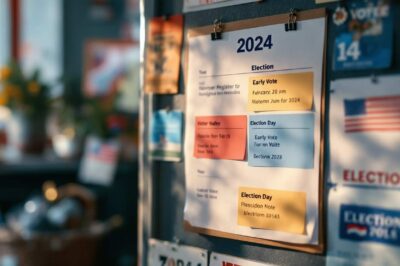The Election 2024 cycle is already shaping up to be a pivotal moment in American politics. Citizens and voters are gearing up for what promises to be an engaging and contentious atmosphere. With various events, processes, and candidates coming into play, it is essential to understand the critical details surrounding the election date and what to anticipate in the coming months.
Understanding the Election Process
The election process in the United States is complex and multifaceted, involving a series of steps that ensure both democratic participation and representation. It begins with primaries and caucuses, which serve as the preliminary channels for candidates to secure their party’s nomination. Understanding these components is crucial for anyone looking to follow the upcoming elections closely.
The Role of Primaries and Caucuses
Primaries and caucuses are the first steps in the election process, determining which candidates will represent each political party in the general election. Primaries can be open or closed: in an open primary, any registered voter can participate, while in a closed primary, only registered party members can vote.
Caucuses, on the other hand, are a more intricate process involving local gatherings where voters discuss and vote for their preferred candidate. The outcomes of these early contests set the stage for the nomination process and often significantly influence the perception of candidates’ viability. For instance, a strong performance in the Iowa caucus can generate momentum for a candidate, leading to increased media attention and fundraising opportunities. Conversely, a poor showing can spell the end of a campaign, highlighting the high stakes involved in these early contests.
The Electoral College Explained
Once the party nominees are established, the election culminates in the general election, where voters cast their ballots. However, the U.S. employs the Electoral College system, which can seem baffling at first glance. Each state is allocated a number of electors based on its population, and these electors formally cast votes for the president and vice president.
A candidate must secure a majority of electoral votes—at least 270 out of 538—to win the presidency. This system means that it’s possible for a candidate to win the popular vote nationwide and still lose the election, as seen in previous contests. Understanding this peculiar dynamic is essential for predicting election outcomes and potential shifts in voter allegiance. Additionally, the winner-takes-all approach used by most states amplifies the importance of swing states, where both parties have similar levels of support. Campaign strategies often focus heavily on these battlegrounds, as a small shift in voter sentiment can lead to a significant electoral advantage.
Key Dates for the 2024 Election
As we look ahead to 2024, several important dates are on the horizon that voters should mark on their calendars. These dates will guide individuals as they engage in the democratic process, from casting ballots to participating in caucuses and primaries.

Primary and Caucus Dates
The primaries and caucuses for the 2024 election season are scheduled to begin early in the year, with various states hosting their events at staggered intervals between February and June. Iowa and New Hampshire are traditionally the first to hold their caucus and primary, often seen as bellwethers for national sentiment toward candidates. These early contests are not just about selecting delegates; they also serve as a critical testing ground for candidates’ campaign strategies, messaging, and grassroots support.
Other states will follow, culminating in a series of critical contests, including Super Tuesday, when a significant number of states hold their primaries. This day can dramatically shift the momentum of the race, as candidates either solidify their front-runner status or face the reality of dwindling support. Being aware of these dates is crucial for engagement and ensuring that individual voices are heard in the process. Voters should also consider attending local events, town halls, and debates leading up to these dates to better understand the candidates’ platforms and to make informed choices.
General Election Date
The general election for the presidency will take place on Tuesday, November 5, 2024. This date typically falls on the first Tuesday after the first Monday in November and is set by law. Voters will have the opportunity to cast their ballots for their preferred candidates in various races, including congressional seats, state offices, and local measures. The general election is a culmination of months, if not years, of campaigning, debates, and voter outreach efforts, making it a pivotal moment in the democratic process.
As the general election date approaches, it will be vital for voters to stay informed about any potential changes to voting procedures or requirements in their states, including registration deadlines and mail-in voting options. Many states are also ramping up their efforts to educate voters about the voting process, including the importance of verifying their registration status and understanding the logistics of polling places. Engaging with local civic organizations can provide additional resources and support for those looking to navigate the complexities of voting in the 2024 election.
What to Expect in the 2024 Election
The 2024 election will undoubtedly be a critical juncture for many issues, with strong implications for both domestic and foreign policy. Voters should brace themselves for intense campaigning and heightened discussions about candidates’ platforms and potential voter turnout.

Potential Candidates and Their Platforms
As of now, a diverse array of candidates is emerging across the political spectrum, each with their platforms that reflect the values and concerns of their constituencies. On the Democratic side, incumbents and challengers alike are likely to focus on health care reforms, climate change, and economic recovery, while Republican candidates may highlight issues such as immigration, national security, and economic growth.
Voter alignment with candidates’ platforms will be essential in determining how the election unfolds, and debates will play a vital role in shaping public opinion. Keeping an eye on candidates as they campaign will be crucial for understanding the potential direction of the election. Additionally, grassroots movements are expected to gain momentum, with organizations advocating for issues like social justice and environmental sustainability, which could influence the platforms of mainstream candidates. The intersection of traditional campaigning and modern advocacy will create a dynamic landscape that voters must navigate.
Predicted Voter Turnout
Predicting voter turnout can be tricky, but several trends suggest increased engagement in the 2024 elections. Historically, presidential elections tend to draw larger voter participation than midterms, and with heightened awareness around civic participation, there may be an uptick in turnout, particularly among younger generations.
Factors such as key issues, candidate charisma, and the influence of social media may all converge to either stimulate or dampen voter enthusiasm. Understanding these dynamics can help in anticipating the overall turnout and its implications for the results. Furthermore, the role of technology in facilitating voter registration and education cannot be overlooked. Many organizations are leveraging mobile apps and online platforms to streamline the voting process, making it easier for citizens to engage. This technological shift, coupled with a growing emphasis on the importance of voting, may lead to unprecedented levels of participation, particularly in demographics that have historically been underrepresented at the polls.
The Impact of Redistricting on the 2024 Election
Redistricting—an often contentious part of the electoral process—will also play a significant role in the 2024 elections. Every ten years, following the census, congressional district lines are redrawn, which can affect representation and electoral outcomes.

Changes in Congressional Districts
With the redistricting that takes place after the 2020 census, several states will see changes in their congressional districts. Depending on how the lines are drawn, some incumbent representatives may find themselves in more favorable or more challenging districts, potentially altering their chances of re-election.
This process can also create opportunities for new candidates to emerge in these revamped districts, injecting fresh perspectives into the race. Understanding the implications of redistricting will be key for observers and voters alike.
How Redistricting Could Influence the Election Outcome
Redistricting has far-reaching consequences for electoral outcomes. It can create “safe” seats for incumbents or competitive battleground districts that ignite fierce electoral battles. Analyzing how these changes affect the political landscape is crucial for predicting how various races will play out.
Furthermore, redistricting can impact voter sentiment and engagement in different areas, making it a significant factor to consider as the election approaches and polling evolves.
The Role of Technology in the Election 2024
Technology continues to reshape the political landscape, particularly in the realm of elections. As we head toward 2024, advancements in social media and cybersecurity will influence everything from campaigning to voter outreach and communication.
The Use of Social Media in Campaigns
Social media platforms have become vital tools for political campaigns, offering candidates unprecedented access to potential voters. The ability to share messages, engage with constituents, and mobilize supporters online can define the success of a campaign.
Candidates are likely to harness platforms like Twitter, Facebook, and Instagram to promote their message and to respond quickly to political events. Voter engagement through digital means will likely play a formative role in the outcome of the 2024 election.
Cybersecurity and Election Integrity
As technology continues to advance, so do concerns over cybersecurity and election integrity. With previous election cycles highlighting vulnerabilities in systems and potential interference, safeguarding the electoral process has become a priority for election officials and voters alike.
Ensuring secure voting systems and protecting against malicious threats will be crucial in maintaining public trust in the electoral process. As the 2024 election combines traditional methods with technological advancements, addressing these concerns will be paramount.
In conclusion, the 2024 election promises to be both exciting and complex, with key dates, candidates, and issues shaping the race. By staying informed and engaged, voters can play an essential role in shaping the democracy they wish to see.











Latest Posts
Election 2024 Date: Key Details and What to Expect
Exploring the Best Tamil MV: Top Picks and Trends #3
TamilMV: Exploring the Popularity and Controversies Surrounding the Platform